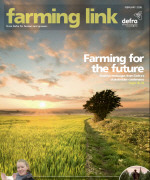



Containing Avian Influenza
UK - Following January’s H5N1 case in wild birds in Dorset, Stephen Lister, one of the local veterinary inspectors during the November outbreak in Suffolk, told Farming Link about the processes involved in containing the disease.One unenviable milestone of 2007 was the arrival in February of the highly pathogenic H5N1 Asiatic strain of avian influenza in commercial poultry. This virus has stolen headlines around the world in recent years, and unfortunately there was a certain inevitability about its arrival in the UK.
The fallout and disruption from such outbreaks is immense for the poultry industry. The year ended with a further outbreak of H5N1 in turkeys in November, having had a small outbreak of low virulence H7 flu in backyard chickens in Wales in May. This year started with highly pathogenic H5N1 in wild swans in Dorset. Despite such a difficult year with other disease outbreaks, the avian influenza outbreaks were well contained. This was mainly due to contingency planning, cooperation between industry, local authorities and government, and the actions of keepers.
Detecting the disease
Turkeys remain one of the most sensitive bird species for the virus, so it is perhaps not surprising that in 2007, highly pathogenic H5N1 infections were found in this species. If there is anything good about the virus it is the fact that it is so pathogenic – infected turkeys get very sick, very quickly. This, combined with some eagle-eyed producers and their vets, meant that outbreaks were identified quickly. As with so many diseases, this is the main key to success in control.
Once identified, the normal process is for Defra to declare 3km and 10km Zones around the location of infection with measures to reduce the risk of disease spread, and establish what might be going on in the locality. Much larger zones can be declared where all free range birds are housed to help prevent disease transfer between wild birds and poultry. With the likely involvement of wild birds in the introduction or spread of infection, this helps to prevent the risk of further outbreaks from such a source.
While these measures are sensible, they put a strain both on the industry and various authorities trying to deal with life on a dayto- day basis. Controlled movements within the zones have to be licensed, although where it would not jeopardise disease control, general licences are made available. The GB Poultry Register aided identification of flocks of more than 50 poultry.
At times like these, everyone is in danger of disappearing under a mountain of paperwork. However, the underlining strategy makes sense – identify the source, identify any infected premises and prevent the risk of spreading disease elsewhere.
Keeping on top of disease
- Be vigilant – contact your vet whenever you are concerned about your stock.
- Take advice – speak to your vet and other specialists.
- Reduce your risk – work out how disease might get onto your premises and act on your conclusions.
- Talk to your neighbours – be aware of who is doing what in your area, so that you can liaise and reduce overall risks.
- evelop a contingency plan – how would you operate if you had to farm in a zone with movement restrictions?
- Register your poultry – all keepers of 50 or more poultry (such as chickens, turkeys, ducks, geese, game birds, pigeons (for meat production) and ostriches) must register with Defra. Those with fewer than 50 are also encouraged to register.
Defra update
Sporadic outbreaks of avian influenza are ongoing across Europe, and disease has been found in both domestic and wild birds in locations across the continent. According to the World Organisation for Animal Health (OIE), there were more than 300 reported outbreaks of H5N1 in nine European countries during 2007. These included outbreaks in commercial poultry (broilers, ducks and geese), outbreaks in backyard poultry (village poultry), and more than 250 outbreaks in wild birds (swans, wild ducks and wild geese).
Defra has published detailed guidance and advice on measures bird-keepers can take. This can be found on the Defra website.
Further Reading
|
|
- You can visit the Avian Flu page by clicking here. |












